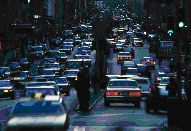
Murrieta & Quality of Life
A Summary of Murrieta, by John Husing
The City of Murrieta
Murrieta is a young city, incorporated in 1991.It is one of Southern California’s fastest growing places thanks to a climate that is milder than most inland areas, a location adjacent to the Santa Rosa plateau and its proximity to San Diego County. The city’s housing stock is very new and much of it is upscale.It has thus become a location of choice for people being priced out of San Diego County ’s increasingly unaffordable housing markets (91% of San Diego County ’s families cannot qualify to buy its median priced existing home). The city’s economy is expanding with a growing base of retail and office firms. The local schools are excellent. Crime is the lowest among the inland region’s major cities.The city is developing an enviable park system with 49 sites encompassing 551.5 acres. These facts are reflected in the community’s demographics.
Murrieta’s primary economic challenges are similar to those faced by other inland “edge” cities like Corona and Rancho Cucamonga. Demand for executive homes within these cities is surging, driven by younger, high-end families migrating away from soaring coastal housing prices.They are moving inland and bringing their educations and skills with them. Thus, from 2000-2004, the Inland Empire saw the number of people with bachelor’s degrees or higher rise by 119,195, up 38.2% to 431,452. In Murrieta’s case, the key to this trend is the fact that just 9% of families in nearby San Diego County can afford its median priced home.As a result, the city has been in the midst of a sustained upscale housing boom. By 2005, 24.3% of Murrieta’s residents had 4-year college degrees or higher (Inland Empire average: 18.9%).
While these new residents work in skilled occupations, there are few such jobs available for them in the Southwest Riverside County. True, the area’s economy has grown, however, it has not added jobs nearly as rapidly as people.The result has been a jobs:housing ratio of 0.86, far below the 1.25 jobs per occupied dwelling needed for jobs self-sufficiency.In human terms, this translates into large numbers of workers having to commute from the area.
As a result, Murrieta and other Southwest Riverside County cities see a daily “brain drain” as many residents drive long distances to professional, high technology or corporate jobs in San Diego or Orange counties, near their former coastal homes. The area’s economic strategies should be designed to use this growing base of skilled workers to attract high income jobs and relieve the commuter strain on families, freeways and the community.
That said, the very existence of this well-educated population, together with the idyllic environment of Murrieta both physically and in terms of its neighborhoods, schools, and public safety, provides the city and its neighbors with competitive advantages that can be used to stimulate high-end job growth. Since 2000, in particular, the city has seen its economy begin to mature.Office buildings like Crossroads Corporate Center are full with new buildings being added to the campus.Sites, such as the 126 acre Jefferson Avenue Office Park , are starting to be developed. Some 20 commercial and retail center projects are being planned and built.
They range from large projects like The Triangle at the I-15 and I-215 junction that will include retail outlets, offices, a hotel, a meeting center and an amphitheater, to numerous mid-sized and smaller facilities. For this reason, the city’s economy is very much a work in progress.This presents the current generation of leaders with the opportunity to have a substantial influence over the nature of the city’s future. These statements flow from reviewing hard data about Murrieta’s demographics, economics and quality of life.
Compiled by: John E. Husing Ph.D.




